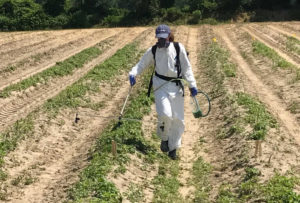Date: March 5, 2020
Time: 8:00 am – 3:00 pm
Location: RAREC – 121 Northville Road, Bridgeton, NJ 08302
Pre-Registration: Required, Contact: Karen Holton (holton@njaes.rutgers.edu) or (856) 455-3100 x 4104
Cost / person: $15.00 (Checks preferred, made out to Rutgers University) Lunch: Included
Pesticide Credits: Requested for – Core, PP2, 10, 1A, 3A and 3B
Program
8:00 am Registration Coffee and pastries
8:25 am Welcome and Opening Remarks
Daniel Ward, Director, Rutgers Agricultural Research and Extension Center
Hemant Gohil, Agriculture Agent, Rutgers Co-op. Extension, Gloucester County
8:30 am Peach Bacterial Spot Management: Comparison of Copper Compounds and Rates
Norm Lalancette, Extension Specialist in Tree Fruit Pathology, Rutgers NJAES
9:15 am Pollinator Stewardship in Orchards
Julianna Wilson, Academic Specialist, Tree Fruit Integrator, Michigan State University
10:00 am Break – Coffee and pastries
10:15 am Integrating Management for Key Orchard Pests
Anne Nielsen, Extension Specialist in Tree Fruit Entomology, Rutgers NJAES
10:45 am Recommendation Updates for Tree Fruit Insect Management w/ Special Attention to Bee Safety.
Dean Polk, Statewide Fruit IPM Agent, Rutgers NJAES
11:15 am Pesticide Regulatory and Safety Update for 2020
George Hamilton, Extension Specialist in Pest Management, Rutgers NJAES
11:45 am Industry Updates and NJ Peach Promotion Council Updates
12 Noon Lunch
1:00 pm Updates on tree fruit soil fertility management in New Jersey
Megan Muehlbauer, Agriculture Agent, Rutgers Co-op. Extension, Hunterdon Co.
1:30 pm Soil Health – A Panel Discussion
Daniel Ward, Extension Specialist, Pomology; Joseph Heckman, Extension Specialist, Soil Health; Thierry Besancon, Extension Specialist, Weed Science; Lewis DeEugenio, Fruit Grower, Summit City Farms; Robert Muth, Fruit and Vegetable Grower, Muth Family Farms; Megan Muehlbauer, Agriculture Agent.
2:30 pm Updates on Peach and Nectarine Breeding Program
Joseph Goffreda, Tree Fruit Breeding, Rutgers University
3:00 pm Open Session – Grower Questions and Discussion
Pesticide re-certification credits
Please contact Hemant Gohil (Program Organizer) at gohil@njaes.rutgers.edu or 856-224-8029 if you have any questions.

